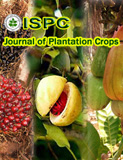Waste to wealth generation via areca plate manufacturing on micro scale
DOI:
https://doi.org/10.25081/jpc.2024.v52.i1.9174Abstract
Areca leaf sheath which was hitherto wasted on the garden has found profound importance in the hands of microenterprise owners. Value has been added to leaf sheath through their conversion into biodegradable plates and bowls. Micro scale production units are concentrated in arecanut hinterlands of Karnataka. The study was conducted considering 30 micro units from Shivamogga and Davangere districts of Karnataka. The average of total cost incurred, gross returns and net returns realized over the production period of six months was Rs. 315518.40, 4,21,000, 1,89,467 respectively. Profitability reflected in the Benefit Cost Ratio of 1.33 indicating that every rupee invested on plate manufacturing unit enabled manufacturer to reap gross returns of Rs. 1.67. Waste to wealth generation not only results in income generation but also results in employment generation for rural folk.
Downloads
References
Anonymous,2018, Directorate of Arecanut and Spices Developments, Calicut
Anonymous,2018, www.export import of areca plates.
Anonymous, 2022, Package of practice of horticulture crops, Published from University of Horticultural Sciences, Bagalkot, Karnataka pp.206
Chinnappa, B., Kiran Kumar, R. Patil, Manjunatha, G. R. and Soumya, H.S.,2020, Economic utilisation of Areca leaf sheaths for rural livelihood, Indian J. Agri Economics, 75(1),2020.
Gurumurthy, S. B., Patil, S.V., Shankarappa, T. H and Prashantha, A, 2018, Bioconversion of Arecanut Husk; Residue to Compost v i a M i c r o b i a l C o n s o r t i a , Int.J.Curr.Microbiol.App.Sci , 7(8): 2883-2888.
Kirankumar, R. Patil., Chinnappa, B., Manjunatha, G. R. and Sowmya, H. S.,2019.Eco-friendly Arecanut leaf sheath products: An economic analysis. Indian J. Eco.46(2):431-436.
Nagaraja, R., Gurumurthy, B. R and Shivanna, M.B., 2014, Bio softening of arecanut waste areca husk, leaf and leaf sheath for value added compost, Int. J. Res. Applied., 2(9): 105-112.
Nagarajappa Adivappar, Hanumanthaswamy, B.C. and Shashidhara, K.C.,2014. Conversion of Areca leaf sheath into eco-friendly plates: A case study of remunerative micro enterprise. Inter. J. Trade & Global Bus. Pers.1(3):2319-9059.
Vishwajith, K. P., Sahu, P. K., Dhekale, B. S., Noman, M.D. and Mishra,P., 2015, Exploring the feasibility of arecanut based farming systems in augmenting farm economy- a case study in Karnataka, India. J. Crop. Weed., 11:127-133.
Published
How to Cite
Issue
Section
Copyright (c) 2024 Journal of Plantation Crops

This work is licensed under a Creative Commons Attribution 4.0 International License.







 .
.